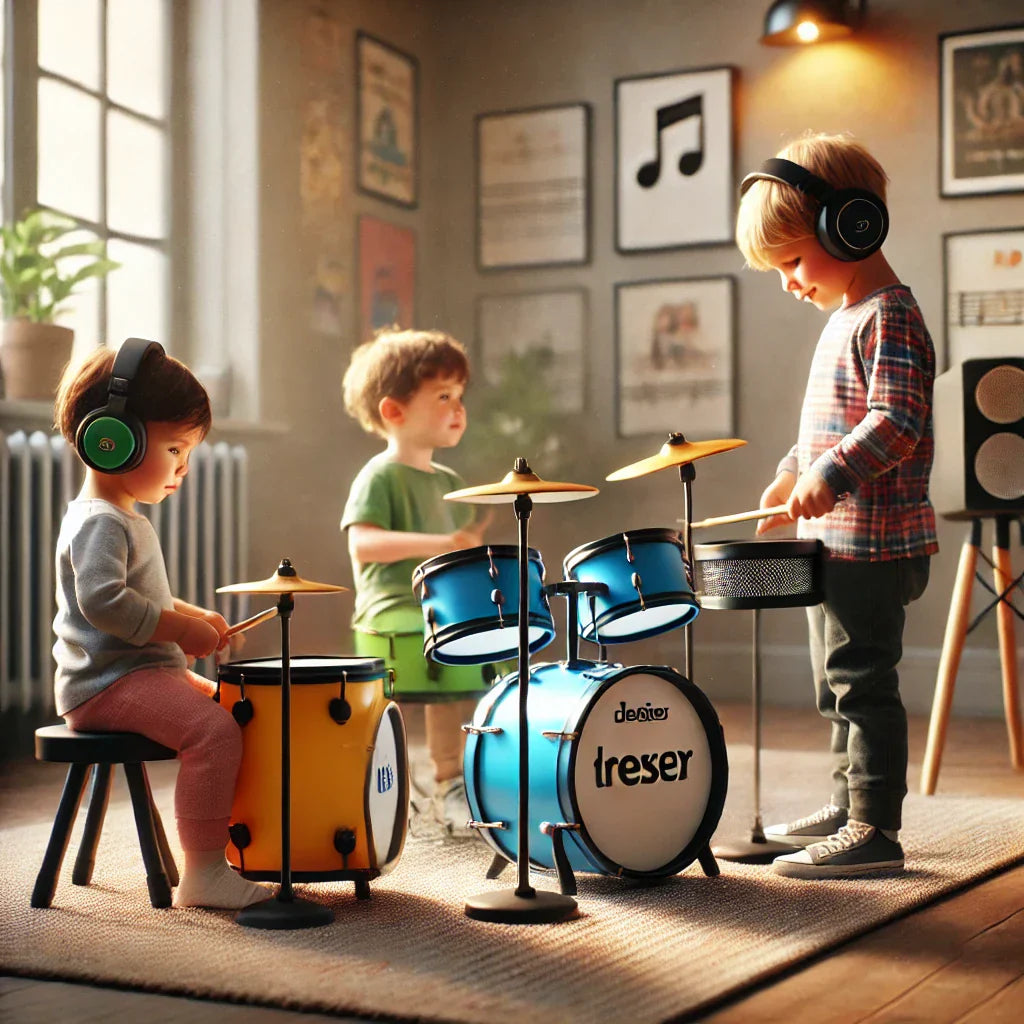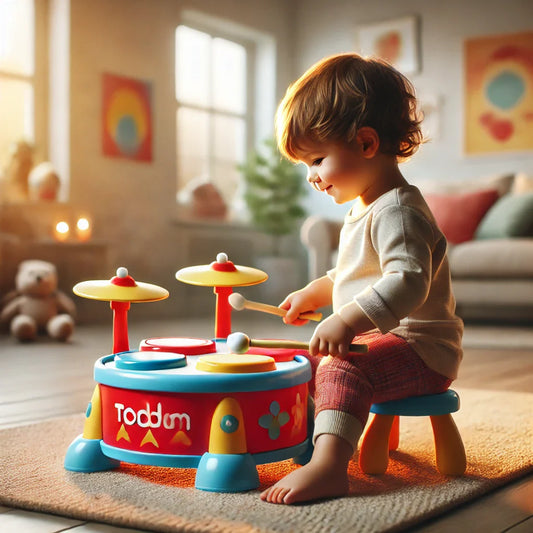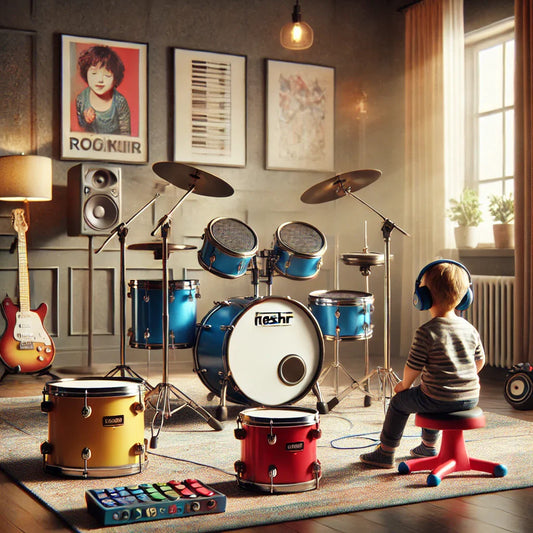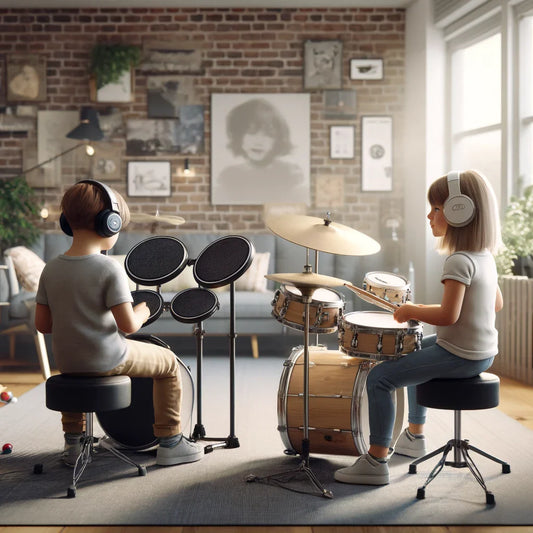Introduction
Thinking about buying your child their first drum kit? Whether your little one is just discovering rhythm or already jamming with makeshift drumsticks, finding the right set can make all the difference in their musical journey. But here's the thing—not all drum kits are created equal, and what works for a 7-year-old might completely overwhelm a 3-year-old.
Choosing the right drum kit for kids age 3, 5, or 7 isn't just about fun—it's about ensuring the kit matches your child’s physical size, developmental stage, and attention span. The right set can spark creativity and skill-building, while the wrong one might frustrate them or even gather dust in a corner.
In this age-based guide, we’ll walk you through how to choose a drum set that fits your child perfectly—physically and musically. We’ll also highlight top-rated kits like the MX510 Electric Drum Kit for older kids and the Children’s 4pc Drum Kit Black for early beginners to help you shop confidently.
Why Age Matters When Choosing a Drum Kit
Just like shoes, backpacks, or bikes—drum kits need to be age-appropriate to be effective (and enjoyable). Here’s why your child’s age should guide your buying decision:
1. Physical Development
-
Reach & Limb Control: Young children have shorter arms and less coordination. A full-size kit will feel like an obstacle course rather than a fun toy.
-
Hand Strength: Age-appropriate sticks and pad resistance are essential for comfort and muscle development.
-
Seating & Posture: A stable, adjustable stool is a must-have to prevent fatigue or back strain.
2. Attention Span
At age 3, most kids love exploring sound but can lose interest quickly if the kit is too complex. Around ages 5 to 7, focus increases—this is where more structured kits make sense.
3. Safety & Comfort
Kits designed for older kids often have more small parts or complex mechanisms. For toddlers and early learners, safety features like rounded edges, soft grips, and volume control are key.
4. Motivation to Play
When the kit feels right—physically and visually—kids are naturally more eager to play, explore, and practice. Confidence leads to consistency.
Best Drum Kits for Age 3
At this age, it’s all about exploration and fun, not structured practice. Kids want to make noise, bang things, and feel like they’re part of the music.
Features to Look For:
-
Colorful and inviting design
-
3-piece layout or fewer
-
Soft or plastic drumsticks
-
Rounded edges and low profile
Types of Kits:
-
Toy Drum Sets: Lightweight, safe, and sometimes musical (with pre-loaded songs or light-up features)
-
Mini Acoustic Sets: Simple, real drum heads but scaled down
Parental Tips:
-
Set up in a quiet play area where noise won’t be disruptive
-
Avoid complicated kits—they’ll overwhelm more than entertain
-
Sit and play with your child to model rhythms
Ideal Kit Example:
A colorful toy drum kit with three pads, a cymbal, and light-up buttons for rhythm play. Bonus if it includes a mic for singing along.
Best Drum Kits for Age 5
By age 5, most kids are physically ready for starter drum kits with real components like bass drums and cymbals. They can start mimicking rhythms and basic beats.
What to Look For:
-
A 3–4 piece kit
-
Real snare, bass drum, and one tom
-
Working foot pedal and stool
-
Drumsticks that fit smaller hands
Recommended: Children’s 4pc Drum Kit Black
This entry-level kit balances authentic feel and child-friendly design:
-
Compact design for young beginners
-
Includes stool, sticks, and hardware
-
Real bass and tom setup with manageable sound
-
Great black finish that looks like a “real drummer’s” kit
Best Practices:
-
Set a small routine: “5-minute jam sessions” after school
-
Encourage rhythm games or play along with music
-
Use headphones or soundproof mats if needed
Best Drum Kits for Age 7
At this stage, your child is likely developing a deeper interest in music—and may be ready for lessons or structured practice. Their physical development can now handle larger kits and more detailed setups.
What to Look For:
-
5-piece kits (snare, bass, two toms, cymbal)
-
Responsive heads and adjustable hardware
-
Sturdy pedals and stool
-
Volume control or electronic pads for quiet play
Top Pick: MX510 Electric Drum Kit
Why it’s ideal for 7-year-olds:
-
Mesh drum heads for quiet, responsive play
-
Built-in coaching features and pre-set tracks
-
Headphone compatibility = peace for the household
-
Complete starter package with cables, sticks, and stool
Encouragement Tips:
-
Enroll in basic drumming lessons or online courses
-
Introduce backing tracks for rhythm practice
-
Celebrate progress—every beat counts!
Electric vs Acoustic Drum Kits for Kids
Once your child is past the age of three and starting to show a real interest in drumming, the big question arises: electric or acoustic drum kit? Both have their pros and cons, and the right choice depends on your home setup, your child’s goals, and your noise tolerance.
Acoustic Drum Kits: Classic Feel and Full Sound
Pros:
-
Realistic response and natural rebound
-
Rich, resonant sound—perfect for performance or band practice
-
Builds solid stick technique from the beginning
Cons:
-
LOUD (and we mean loud)
-
Takes up more space
-
Not ideal for shared living or apartment environments
Best for:
-
Families with a garage, music room, or detached play area
-
Kids taking formal lessons
-
Homes that can tolerate some joyful noise
Electric Drum Kits: Modern, Quiet, and Smart
Pros:
-
Volume control and headphone compatibility = peaceful practice
-
Compact, often more space-efficient
-
Many include coaching functions, backing tracks, and digital features
Cons:
-
Requires power and cables
-
Some kits may not fully replicate acoustic “feel”
-
More tech involved—may need help setting up
Best for:
-
Apartment living
-
Kids who love gadgets or interactive play
-
Households where quiet practice is essential
If you’re not sure, the MX510 Electric Drum Kit offers the best of both worlds. It feels professional, comes with learning tools, and won’t disrupt the whole street.
How Many Pieces Should a Kids Drum Set Have?
Drum kits are often sold by the number of pieces—3-piece, 4-piece, 5-piece, and beyond. But what does that mean, and how do you know what’s right for your child?
3-Piece Kits (Ideal for Ages 3–5)
-
Usually includes: snare, bass drum, one tom
-
Simple layout for toddlers to explore rhythm
-
Often part of toy or mini kits
Best For: Very young children just beginning to explore drumming
4-Piece Kits (Ages 5–6)
-
Includes snare, bass drum, one tom, and a cymbal
-
Offers real practice and helps build proper coordination
Example: Children’s 4pc Drum Kit Black
Best For: Young kids who want a “real” drum feel without overwhelming complexity
5-Piece Kits (Ages 7+)
-
Includes snare, bass, two toms, hi-hat, and crash cymbal
-
Mimics adult drum sets—ideal for progression and lessons
-
Helps kids build skills like stick control, foot coordination, and rhythm
Best For: School-age children serious about learning drums
Pro Tip: You can always add cymbals or extra drums later as your child grows in skill.
Safety Considerations for Kids Drum Kits
Kids + drums = fun. But without proper attention to safety, even a great kit can become a hazard. Here’s what to check before and after setup:
1. Non-Toxic Materials
Ensure all finishes and components are BPA-free, lead-free, and child-safe—especially if your child is under 5 and still puts objects in their mouth.
2. Rounded Edges
Look for smoothed or padded drum rims and stands. Avoid sharp corners or exposed metal on cheap kits.
3. Stool Stability
Many kits come with a stool—but not all stools are safe. Make sure:
-
It's height-adjustable
-
Has a rubber or non-slip base
-
Can support your child’s weight (with wiggle room)
4. Drumsticks
Use kid-sized sticks—they’re lighter, easier to grip, and reduce fatigue. Foam-tipped or rubber-coated sticks are great for early learners.
5. Headphone Volume
If using an electric drum kit, make sure the headphones don’t exceed safe volume limits. Look for kids’ models with volume control or built-in sound limiters.
How to Encourage Regular Practice
Let’s be honest—most kids will love their drum set at first, but staying consistent is a different story. Here’s how to keep them excited (without nagging):
1. Make Practice Fun
-
Use play-along tracks or favorite songs
-
Let them “perform” mini concerts for the family
-
Add games like “follow the rhythm” or “name that beat”
2. Keep Sessions Short and Sweet
For younger kids (under 6), aim for 5–10 minutes a day. Older children can handle 15–30 minutes with breaks.
3. Praise Progress, Not Perfection
-
Celebrate milestones: “You played the whole song!”
-
Take videos and show family—it builds pride and motivation
4. Create a Drum Corner
Designate a small space where your child can drum, store accessories, and feel “official.” Include:
-
Their drum set
-
A drumstick holder
-
Practice chart or sticker tracker
-
A small mat to protect the floor and reduce noise
5. Join Them!
Even if you’re not musical, banging out a rhythm together is a great bonding moment—and encourages your child to keep going.
Final Tips for Choosing the Right Drum Kit
By now, you’ve seen how age, size, and setup all play into picking the perfect drum kit for your child. To wrap it all up, here’s a simple checklist to help guide your final decision.
✅ Age-Based Kit Selection
-
Age 3: Go for toy or toddler-sized 3-piece kits with soft sticks and simple sound features.
-
Age 5: Choose a lightweight 4-piece kit like the Children’s 4pc Drum Kit Black that offers a real drumming feel in a manageable size.
-
Age 7: Ready for full starter kits like the MX510 Electric Drum Kit with features that support learning and progression.
✅ Safety Essentials
-
BPA-free, rounded-edge, child-friendly designs
-
Secure stool and appropriate stick sizing
-
Age-appropriate accessories (no small parts for under 3s)
✅ Practical Considerations
-
Measure your space before buying
-
Think about neighbors—go electric if sound is an issue
-
Check return policies and product warranties
✅ Value Over Flash
It can be tempting to buy the fanciest set on the shelf, but remember: the best drum kit is one your child will actually use. Start simple, upgrade later.
✅ Reviews Matter
Read real reviews from other parents—especially about durability, sound quality, and ease of use. Look for verified buyer feedback and photos when possible.
FAQs
1. What is the best drum kit for a 3-year-old?
Toy-style kits with 3 pieces or fewer are best. Look for models with light-up features, fun colors, and padded sticks. Safety and simplicity are key.
2. Should a 5-year-old start with an electric or acoustic drum set?
Acoustic kits are great if you have space and don't mind the noise. Electric kits are quieter and often come with helpful learning tools, making them a good long-term investment.
3. Is a 4-piece drum kit good for beginners?
Yes! Especially for younger children, a 4-piece setup offers a full drum experience without being overwhelming. It’s a perfect transition from toy kits to real ones.
4. What’s the right stool height for kids?
Most junior drum stools should be adjustable between 30–45 cm. Your child’s thighs should be parallel to the floor with feet flat while seated.
5. Can kids share a drum kit?
Absolutely, as long as the stool and pads are adjustable. For electric kits like the MX510, multiple user settings can make it easier to share.




